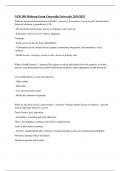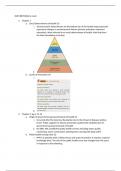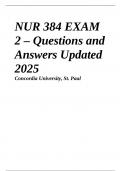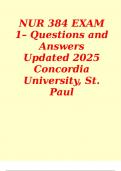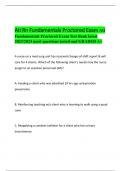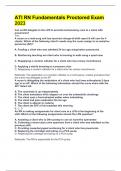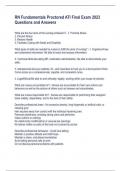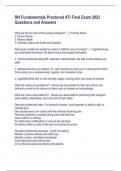Pharmacology Exam 1 Study Guide
Module 1
Lewis: 1-3
ATI: 1, 5
Controlled Substance: Drugs regulated by the FDA and enforced by the DEA that have
a known abuse potential
Schedules:
I (C-I) HIGH abuse potential No medical use (heroin, LSD)
II (c-II) HIGH abuse potential, with severe dependence liability (narcotics,
amphetamines & barbiturates)
III (C-III) Less potential abuse than II, moderate dependence liability
(nonbarbiturate sedatives, nonamphetamine stimulants, etc.)
IV (C-IV) Less potential abuse than III, limited dependence liability (some
sedatives, antianxiety agents, nonnarcotic analgesics)
V (C-V) Limited abuse potential. (small amounts of narcotics (codeine-used
as antitussive, antidiarrheals)
Adverse Effect: drug effects, sometimes called side effects, that are not the desired
therapeutic effects; may be unpleasant or even dangerous
a. What is Stevens Johnson Syndrome?
A drug reaction that results in the skin producing an itchy red rash that can
be fatal
b. Anaphylaxis:
an antibody reaction that causes the release of chemicals including histamine, that
produce immediate reactions (membrane swelling, etc.) that can lead to
respiratory distress and even resp. arrest resulting in death.
c. Discuss types of drug induced tissue and organ damage, toxicity, alterations
in glucose
metabolism, electrolyte imbalances, sensory effects, neurological effects, and
teratogenicity.
d. Describe the types of medication-medication interactions and give
examples of each. Identify examples of food-medication interactions.
Allergy: after exposure to a protein the body can produce antibodies to that protein. A
future exposure can result in an immunological reaction that can range from mild
(itching/redness) to severe (anaphylactic shock)
a. What is the difference between a medication adverse effect and a
medication allergy?
An adverse effect is an expected negative reaction to a drug, an allergic reaction is
the bodies defense mechanism mounting an immune response against a drug.
b. Differentiate between primary and secondary actions of
medications, hypersensitivity
reactions, and allergic reactions to medications.
Pharmacokinetics: the way the body deals with a drug, including absorption,
distributions, biotransformation (metabolism) and excretion.
a. Explain pharmacodynamics and pharmacokinetics.
Pharmacokinetics is the way the body processes a drug, (biological function)
while Pharmacodynamics how the drug affect the body (Drug properties).
b. List the routes of medication administration and their nursing
, implications including advantages and disadvantages.
1. Oral/Enteral:
Advantage: Safe, inexpensive, easy and convenient
Disadvantage: Highly Variable absorption, slow, client
cooperation required
2. Sublingual (under tongue)/Buccal (between check & gum)
Advantage: directly enters bloodstream
Disadvantage: Client cooperation required
3. Topical (Applied to skin)
Advantage: painless, limited adverse effects
4. Transdermal (skin patch)
5. Eye, Ear, Nose
6. Rectal Suppositories, Vaginal
Absorption time varies
7. Inhalation (MDI-metered dose inhaler, DPI-dry-powder inhaler)
8. Nasogastric and Gastrostomy tubes
9. Parenteral (IV)
Advantage: Fast Disadvantage: lower dose =higher toxicity risk
10. Intradermal
11. Subcutaneous/Intramuscular (IM)
12. Intravenous (IV)
Advantage: Rapid onset & absorption. Can give precise amount
Disadvantages: Expensive, inconvenient, since absorption is instant the
risks
associated with wrong/medication dose increased
13. Epidural
IV in epidural space in 4-5th vertebra
b. How does the route of administration impact pharmacokinetics
a. Some medication routes bypass liver (IV administration) bypassing the
first-pass effect and drug metabolism/biotransformation, having
increased speed to peak, and decreased conversion (increased toxicity)
Half-Life: the time it takes for one half of the amount of drug to decrease to half of the
peak level it previously achieved.
Pharmacodynamics: the study of the interactions between the chemical components
of living systems and the foreign chemicals, including drugs, that enter living organisms;
the way a drug affects a body.
a. Contrast medication agonists with medication antagonists.
Agonist: a drug that binds to a specific receptor site producing a similar
response to a chemical that would bind to that same site in the body,
Antagonist: binds the same or a different receptor site inhibiting the
response of a specific chemical.
Polypharmacy: The practice of taking several medications simultaneously.
a. How does polypharmacy impact the elderly?
a. Because the elderly have a decreased medication metabolism, they may
have an increased blood level of medication, and the medication may
stay in their system longer. Polypharmacy complicates this matter
because it increases their risk of drug-drug interactions resulting in
adverse effects, and risk of toxicity.
Toxicity: the sum of poisonous/adverse effects to exposure to a toxic substance by
mouth, through the skin/respiratory tract



